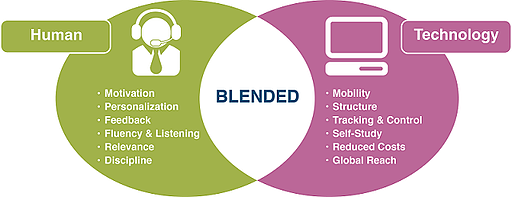Of all the lessons learned in the corporate training domain during the 2020 pandemic era, the power of online learning no doubt tops the list in most, if not all, organizations.
As companies enter the post-pandemic stage and return to a new state of normal, online learning remains at the foreground of training.
Even so, corporate trainers will have to don their creative thinking caps to enhance this component of instruction and work to skillfully weave it together with live training sessions to produce a meaningful blended learning approach that will pack a punch for all organizational team members.
The New Gold Standard for Training Delivery?
With many organizations transitioning to a hybrid model that is seeing team members working in-office and remotely at home, more companies are turning to blended learning to fulfill their corporate training needs. In fact, a 2021 Mark In Style report found that 73% of teachers acknowledged there was greater student engagement through this system of learning. But what should it encompass and how can you execute this to meet the needs of your learners while keeping them engaged, whatever their workplace environment has transitioned into?
Blended learning involves using a diverse range of teaching methods and resources to offer more effective learning experiences. Initially adopted by the post- secondary world as “Open Learning” or "Flexible Learning", this mode of learning consists mainly of online courses supplemented by face-to-face seminars in local centers, access to personal tutors, and ad hoc support groups. Other models see students guide themselves through source content on their own time and then attend group discussions and seminars to solidify understanding and application of the information in the corporate environment.
Essentially, blended learning is nothing new. Organizations have always accommodated team members who have had to balance heavy workloads with family commitments—not to mention business travel and so have had to put together some form of blended learning. Home study and information binders have been utilized for decades. However, the options for blended learning have expanded exponentially as new forms of open source technologies for online learning emerge and with the emergence of hybrid work arrangements.

Blend Creatively
One word of caution: don’t be tempted to use the technology just because it’s there. Use it when it makes the most sense—due to the context for your students or the nature of the material to be delivered. And use it creatively. For example, don’t just upload a lecture. Use the technology to upload case studies, videos etc. and then set the expectation that students will participate in face to face seminars fully informed and ready to engage in the session in a meaningful way. Perhaps you might ask learners to bring real live work experiences and problems to the discussion. No one will be slacking off when they know they will be asked to actively participate in the session.
It’s possible and a good idea to also incorporate social media tools. There are online course platforms capable of integrating open web tools linking to YouTube videos or custom blogs using built-in plug-ins. The artificial divide between your Learning Management System and open web tools disappears and is seamlessly integrated.
The best blended learning programs adapt to the learning styles of your trainees. Think about your audience; what form of delivery will best motivate and captivate them? What is their level of technological literacy? Will they be inspired by more traditional face- to-face presentations or is this a group likely to be captured by integrating web-based media or maybe even a gamified application. The list goes on with a gamut of options to choose from that will enable more effective use of time for both your instructors and learners.
Incorporate these top 7 digital classroom tools to make online learning more effective.
To further amplify learners’ training experience, create a complementary learning system where course participants have control over the direction and pace of their studies and therefore build into them excitement to engage with the course content. Putting out a training program that combines the best features of online and in-person instructional formats paves the way to a truly integrated learning environment that is sure to optimize your team’s learning experience.




